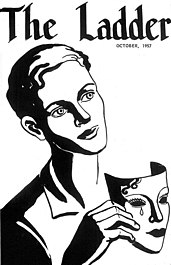The Ladder (Magazine)

The Ladder, October 1957
|
|
| Editor |
Phyllis Lyon Del Martin Barbara Gittings Helen Sandoz Barbara Grier |
|---|---|
| Categories | Newsmagazine |
| Frequency | Bimonthly |
| Publisher | Daughters of Bilitis |
| First issue | October 1956 |
| Final issue | 1972 |
| Country | USA |
| Language | English |
The Ladder was the first nationally distributed lesbian publication in the United States. It was published monthly from 1956 to 1970, and once every other month in 1971 and 1972. It was the primary publication and method of communication for the Daughters of Bilitis, the first lesbian organization in the US. It was supported by ONE, Inc. and the Mattachine Society, with whom the DOB retained friendly relations. The name of the magazine was derived from the artwork on its first cover, simple line drawings showing figures moving towards a ladder that disappeared into the clouds.
The first lesbian publication in the United States was a newsletter called Vice Versa, subtitled "America's Gayest Magazine". It was created and edited by a secretary named Edith Eyde (using the pseudonym Lisa Ben, an anagram of "lesbian") in Los Angeles, and distributed privately in that area from 1947 to 1948.
The first edition of The Ladder appeared in October 1956, edited by Phyllis Lyon, who co-founded the Daughters of Bilitis in 1955 with Del Martin, both of whom had journalism experience. Many of its contributors used pseudonyms or initials. Lyon edited The Ladder as "Ann Ferguson" for the first few months, but dropped the name as a way of encouraging their readers not to hide. It was a newsletter of a dozen or so pages, produced on a typewriter, copied by a mimeograph, and hand stapled. It included book reviews, news, poetry, short stories, letters from readers, and updates from DOB meetings. In 1959 it took a rare political stance against San Francisco mayoral candidate Russel Wolden who criticized incumbent mayor George Christopher's making the city a haven for "sex deviants."The Ladder was issued in a brown paper covering for the duration of its existence. There were 175 copies of the first issue, and members of the DOB mailed them to every woman they knew who might be interested, including woman professionals in the San Francisco telephone book, and others throughout the United States. It soon became available in newsstands in major cities and by subscription, obtained by word of mouth.
...
Wikipedia
